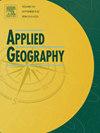干旱城市群生态格局的人为敏感性量化研究
IF 5.4
2区 地球科学
Q1 GEOGRAPHY
引用次数: 0
摘要
人类活动深刻地改变了基本的生态过程,将生态系统推向不可持续的轨道,特别是在生态脆弱的地区,如呼和浩特-包头-鄂尔多斯-榆林城市群。为了应对这些挑战,开发了一个定量框架来评估生态模式的人为敏感性。利用全向电路模型表征区域生态格局,并通过形态分析提取景观要素,构建功能连通性模型。利用地理探测器和结构方程模型探讨了人为敏感性的机制、强度和途径,发现生境质量是一个关键的中介因素。研究结果表明,改善生境质量可显著增强全向连通性。在景观要素中,小岛的连通性低于核心区的边缘,尽管边缘被分配了更高的阻力。在毛乌素沙漠,条状走廊起着连接的作用,但仍然很脆弱,而在库布其沙漠,斑块状走廊主要起着屏障的作用。生境质量和耕地是全方位连通性的主要驱动因素,而人口和裸地则通过相互作用产生负向影响,超过了个体因素的影响。生境质量直接增强了全向连通性,路径系数为0.67。裸地对生境质量的负向影响系数为- 0.65,耕地对草地的负向影响系数为- 0.82,间接塑造了区域生态格局。本研究提供了对生态格局人为敏感性驱动机制的定量认识,为指导和优化干旱城市群生态空间规划提供了有价值的见解。本文章由计算机程序翻译,如有差异,请以英文原文为准。
Quantifying the anthropogenic sensitivity of ecological patterns in arid urban agglomeration
Human activities have profoundly reshaped fundamental ecological processes, pushing ecosystems toward unsustainable trajectories, particularly in the ecologically fragile regions such as Hohhot-Baotou-Ordos-Yulin urban agglomeration. To address these challenges, a quantitative framework was developed to evaluate anthropogenic sensitivity of ecological patterns. Functional connectivity was modeled using an omnidirectional circuit model to represent regional ecological patterns, with landscape elements extracted through morphological analysis. The mechanisms, intensity and pathways of anthropogenic sensitivity were explored using Geodetector and structural equation modeling, identifying habitat quality as a key mediating factor. The findings indicate that improving habitat quality greatly enhances omnidirectional connectivity. Among landscape elements, islets exhibit lower connectivity than the edges of core areas, despite higher resistance being assigned to the edges. In the Mu Us Desert, strip-like corridors serve as connectors but remain fragile, whereas in the Kubuqi Desert, patch-like corridors primarily function as barriers. Habitat quality and cultivated land emerge as dominant drivers of omnidirectional connectivity, while population and bare land contribute negatively through interactive effects that exceed the impacts of individual factors. Habitat quality directly enhances omnidirectional connectivity, with a path coefficient of 0.67. Bare land negatively impacts habitat quality, with a coefficient of −0.65, while cultivated land has a negative effect on grassland, with a coefficient of −0.82, indirectly shape regional ecological patterns. This study provides a quantitative understanding of the mechanisms driving anthropogenic sensitivity in ecological patterns, offering valuable insights to guide and optimize ecological spatial planning in arid urban agglomerations.
求助全文
通过发布文献求助,成功后即可免费获取论文全文。
去求助
来源期刊

Applied Geography
GEOGRAPHY-
CiteScore
8.00
自引率
2.00%
发文量
134
期刊介绍:
Applied Geography is a journal devoted to the publication of research which utilizes geographic approaches (human, physical, nature-society and GIScience) to resolve human problems that have a spatial dimension. These problems may be related to the assessment, management and allocation of the world physical and/or human resources. The underlying rationale of the journal is that only through a clear understanding of the relevant societal, physical, and coupled natural-humans systems can we resolve such problems. Papers are invited on any theme involving the application of geographical theory and methodology in the resolution of human problems.
 求助内容:
求助内容: 应助结果提醒方式:
应助结果提醒方式:


